This post is a sequel to the series I am writing on basic how-to posts on butternut squash. If you need a refresher, be sure to check out my detailed instructions on How to Cut Butternut Squash, How to Roast Whole Butternut Squash, and How to Cook Butternut Squash Cubes in the Air Fryer.
I think we can all agree a plate of roasted butternut squash cubes is one of the easiest side dishes you can serve during the fall. Plus, cooking butternut squash doesn’t require a lot of time and effort, making it an ideal candidate for easy recipes.
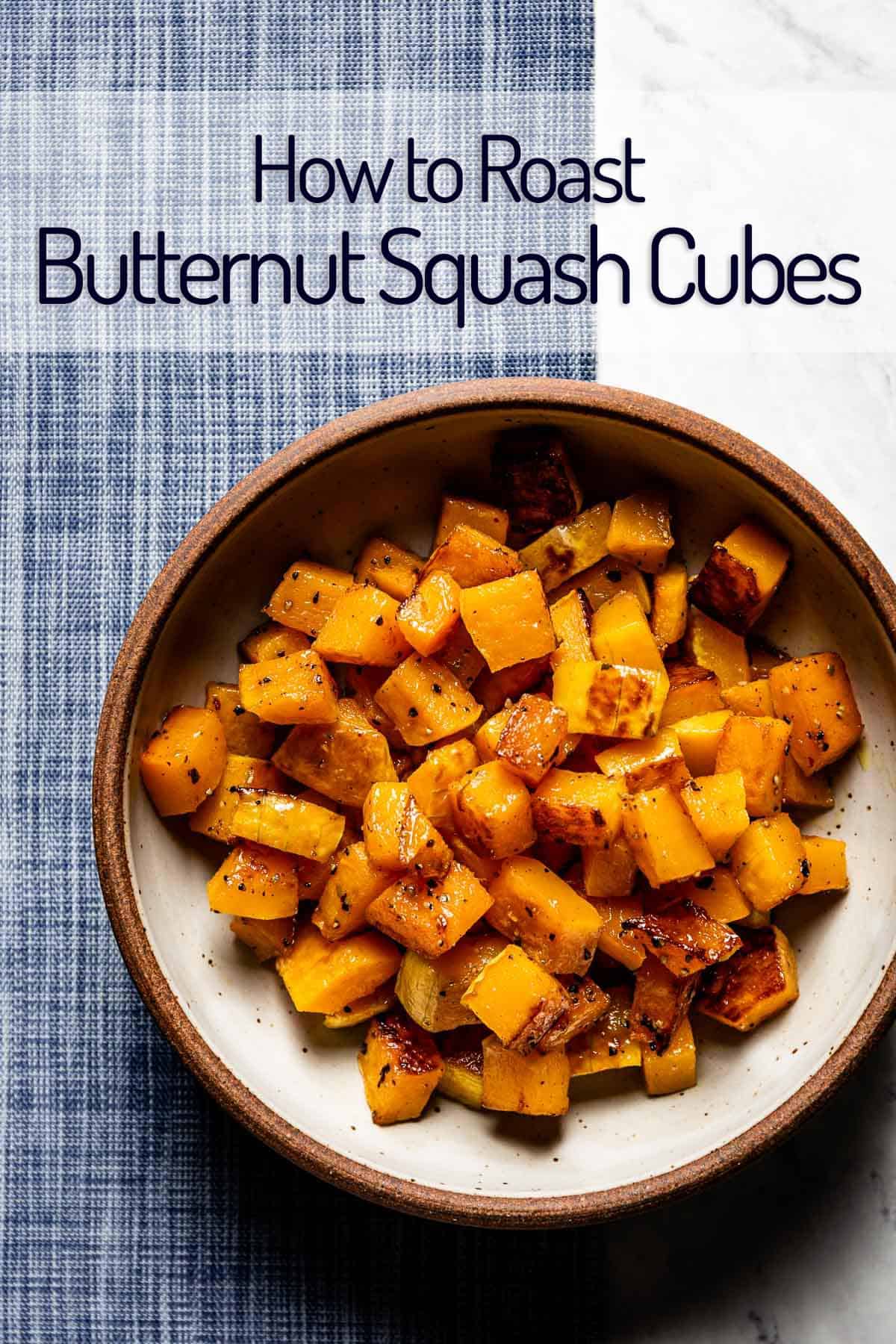
Table of Contents
- Ingredients
- How To Bake Butternut Squash Cubes
- How To Roast Frozen Butternut Squash?
- Seasoning For Butternut Squash
- How To Serve Butternut Squash Cubes? Baked Butternut Squash Recipes You Should Try:
- How To Make Ahead and Store
- Expert tips for perfect results
- FAQs:
- How to Roast Butternut Squash Cubes Recipe
Whether you are looking for a nutritious side dish for your Thanksgiving menu, to embrace this seasonal vegetable, or to meal prep a healthy, hearty lunch using oven-roasted butternut squash, this straightforward recipe is a good one to add to your collection of fall recipes.
Ingredients
This easy roasted butternut squash recipe only requires four simple ingredients! All you need is one medium (approximately 3 pounds) fresh butternut squash, a little olive oil (or any other vegetable oil like avocado oil), kosher salt (or sea salt), and black pepper.
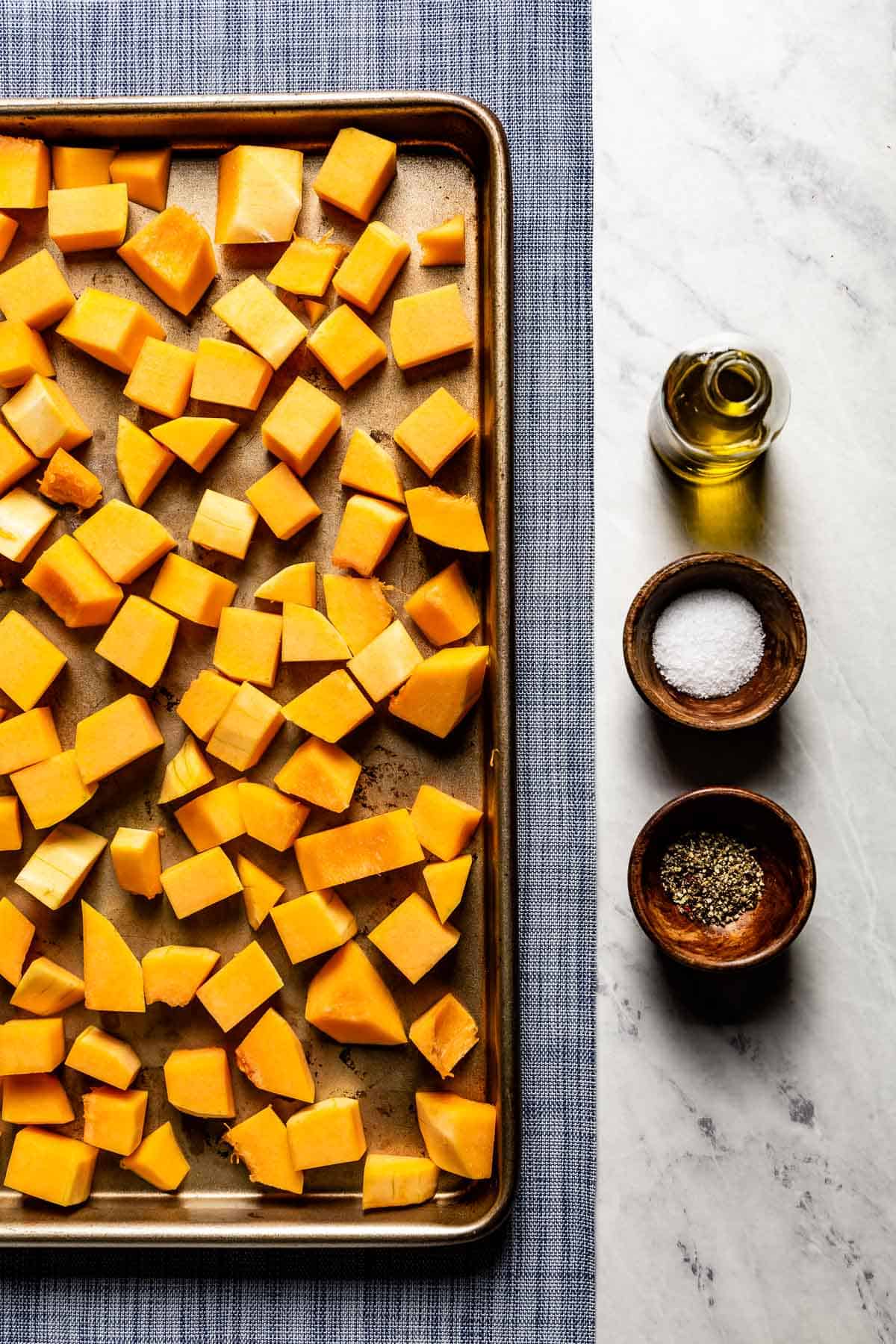
What Spices To Add To Butternut Squash
These spice rack staples will come in handy if you need ideas for seasoning for diced butternut squash. Below are some of my favorite spices I use when I am roasting butternut squash cubes. Feel free to mix and match to make it work for your recipe:
- Ground Cumin
- Ground Coriander
- Pinch of Cayenne Pepper
- Chili Powder
- Curry Powder
- Italian Seasoning
How To Bake Butternut Squash Cubes
These simple steps will teach you how to roast butternut squash cubes in the oven. To do so simply:
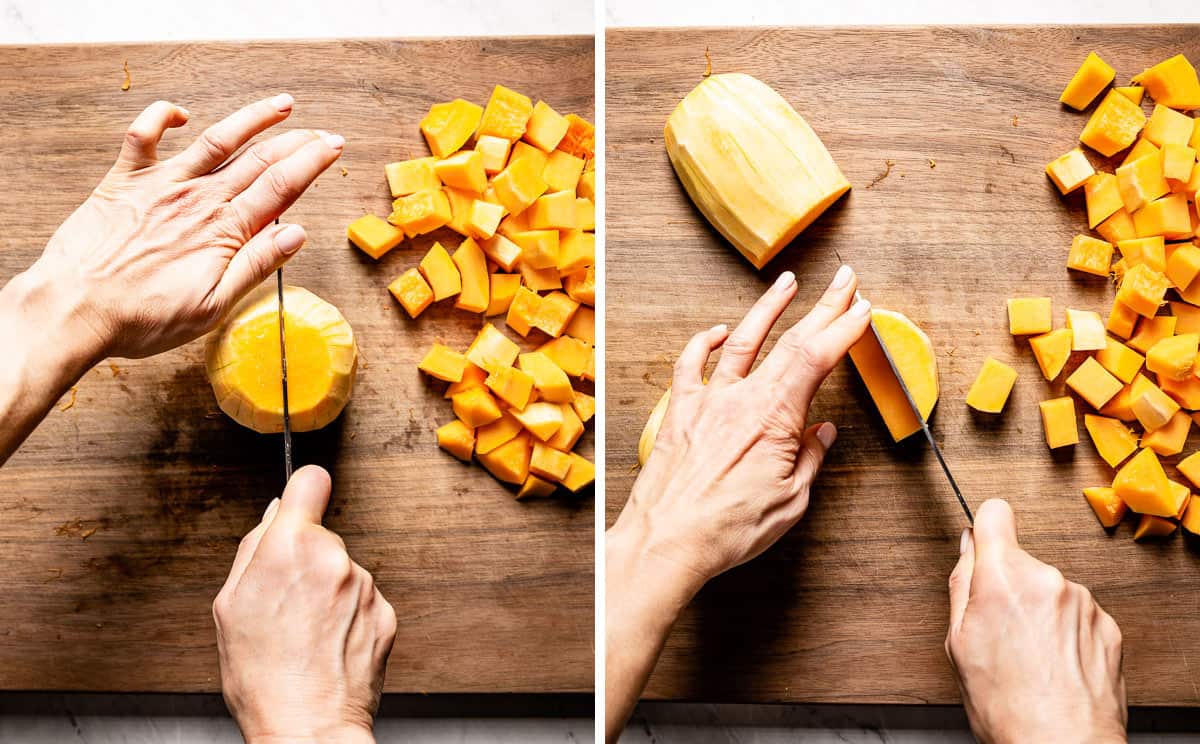
- Cut up the butternut squash: Following my easy method, peel and cut butternut squash into cubes. I recommend cutting them in a uniform size as much as possible to ensure even roasting. I like mine to be 1-inch cubes but you can make them slightly larger or smaller to make it work for your recipe.
- Preheat the oven: Adjust your oven rack to the middle position. Preheat your oven to 425 degrees F.
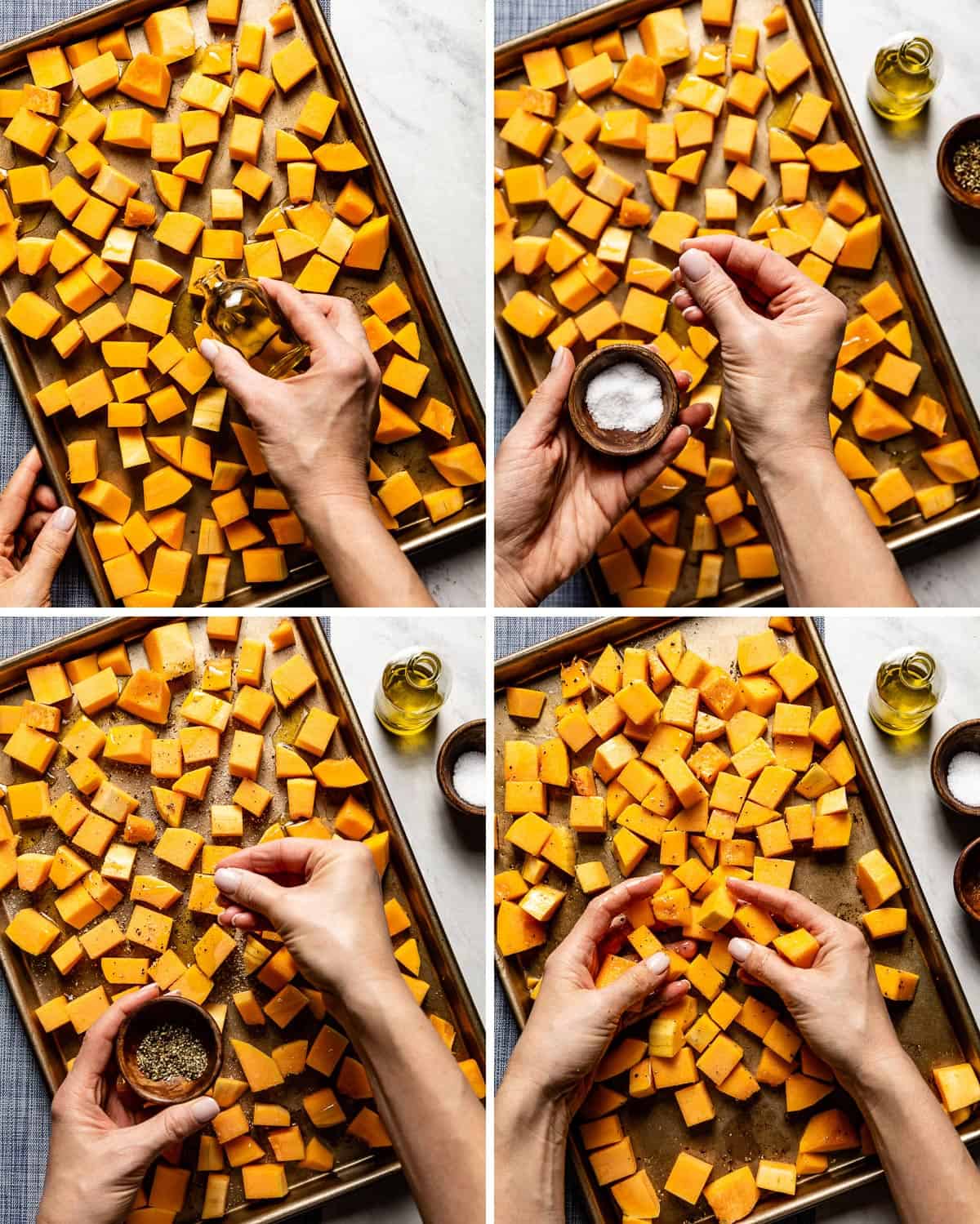
- Add Seasoning: Add the butternut squash cubes to the sheet pan and spread them out in a single layer. Lightly drizzle the cubed butternut squash with olive oil and sprinkle evenly with kosher (or sea salt) and ground black pepper.
- Toss the Squash: Using your hands, a spoon, or a spatula, toss the butternut squash around the baking sheet until it is thoroughly coated with olive oil, salt, and pepper.
- Bake: Bake for 30-35 minutes, stirring halfway through, until the edges of the squash cubes are lightly browned or until a knife can easily be inserted.
- Serve: Transfer to a serving dish and/or use it in your recipe.
What Temperature And How Long To Roast Butternut Squash Cubes?
The amount of time to roast butternut squash is determined by the size of your butternut squash cubes, as well as the preferred temperature setting.
The good news is that you can roast butternut squash cubes at various temperatures. I usually prefer a high temperature, 425 degrees F., oven and bake them for 30-35 minutes. However, you can bake them in lower temperatures as well. Below, I am sharing how long to roast butternut squash cubes at 375 degrees and 400 degrees as well.
However, regardless of the temperature, you are using, I highly recommend checking them after 30 minutes to ensure even roasting.
- 375 Degrees F / 40-45 minutes
- 400 Degrees F / 35-40 minutes
- 425 Degrees F / 30-35 minutes (preferred method)
How To Roast Frozen Butternut Squash?
Purchasing frozen butternut squash cubes is a great alternative to fresh butternut squash. It will save you time on preparing and cutting, especially if you think cutting a whole butternut squash is a daunting task.
Here are the steps to make roasted frozen butternut squash:
- Break up the frozen butternut squash chunks: It is essential to take a moment and break up the frozen butternut squash chunks with your hands. This way, you can easily spread them on the baking sheet and, as a result, get evenly roasted butternut squash cubes in the end.
- Preheat Sheet Pan: While it may come as an extra step, preheating the sheet pan in the oven before adding the frozen butternut squash cubes helps jump-start the roasting process. Because as soon as you place them in a hot baking sheet, the ice on the squash starts to melt, leading to crispier and perfectly roasted diced butternut squash faster.
- Seasoning and Baking: When ready to roast, place the frozen butternut squash cubes in a large bowl. Drizzle with olive oil and sprinkle it with kosher salt and ground black pepper. Give them a toss and carefully spread them onto the hot sheet pan in an even layer. Bake at 450 Degrees F for 20-30 minutes or until they turn light golden brown on the edges.

Seasoning For Butternut Squash
People often ask, what is the best seasoning for butternut squash. And truthfully, there are so many delicious ways to season this versatile vegetable, and you can’t go wrong with any of them. Below, you will find some of my favorite way to season butternut squash:
- Cinnamon Roasted Butternut Squash with Maple Syrup or Brown Sugar: If you are looking to serve the perfect side dish at your Thanksgiving feast this year, consider flavoring it with ground cinnamon and maple syrup (or butternut squash). The natural sweetness of the butternut squash pairs nicely with the earthy flavors of cinnamon and gets even more caramelized thanks to the addition of maple syrup.
- Roasted Butternut Squash with Rosemary: If you wonder what to put on butternut squash for a fall-inspired side dish, try Roasted Butternut Squash with Rosemary. You can use both fresh or dried rosemary for a subtle hint with every bite.
- Herb Roasted Butternut Squash With Garlic: Garlic and herbs are a classic duo that tastes delicious when combined with butternut squash’s creamy, slightly nutty flavor. You can pair a couple of garlic cloves (minced) with any of your favorite fresh herbs, like fresh thyme, parsley, and any savory seasonings that you have on hand. The addition of garlic and fresh herbs makes for a hearty side dish that you can serve with any meal.
- Nuts and Seeds: For a bit of crunch with every bite, consider adding nuts and seeds of your choice on top of your prepared butternut squash. Sprinkling with pumpkin seeds, chopped walnuts, or pecans is a great way to get extra nutrients while elevating the texture of your dish.
How To Serve Butternut Squash Cubes? Baked Butternut Squash Recipes You Should Try:
Now that we covered how to roast butternut squash cubes, it is time to decide what to do with them. Here are some of my favorite ways to serve and a few healthy butternut squash recipes from the archives:
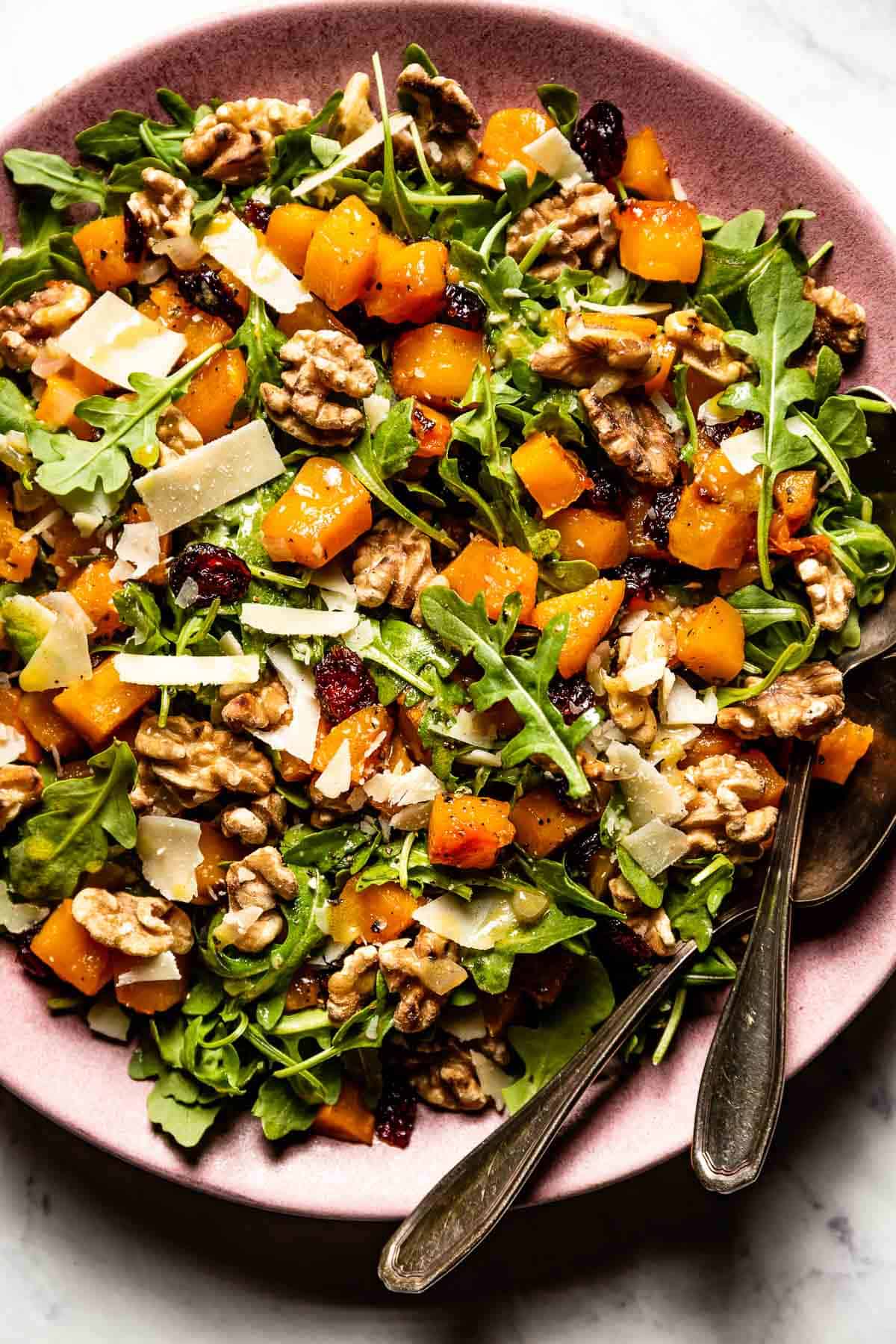
- As A Side Dish By Itself: Because butternut squash carries so much flavor, it’s one of my favorite side dishes to serve. Serve next to any of your favorite chicken or meat recipes, perhaps with a drizzle of my tahini lemon sauce, for a well-balanced, hearty meal.
- Butternut Squash Soup: Roasted butternut squash creates a great base for an elevated Butternut Squash Soup. It is the ultimate heartwarming comfort food to serve on a chilly evening.
- Mash It Up: Butternut squash is an excellent alternative to sweet potatoes or even regular potatoes. Substitute butternut squash in for a sweet, slightly nutty mash that is great to serve as a side dish.
- Add to Salads: Butternut squash can be a hearty, filling addition to your favorite salads or great for meal prepping. Some of my favorite healthy butternut squash recipes are this Barefoot Contessa’s Roasted Butternut Squash Salad, this Roasted Butternut Squash Quinoa Salad, and this Ottolenghi’s Butternut Squash Salad. They are all easy to make, packed with fall flavors, and festive enough to add to your holiday menu.
- Add to Basic Whole Grain Dishes: Basic whole grains dishes like wild rice, bulgur pilaf, quinoa or even black rice compliment roasted butternut squash cubes very well! Fill up a bowl with your whole grain of choice, your butternut squash cubes, and your favorite toppings for a filling and nutritious dish, great for a weeknight dinner or weekly meal prep!
- Incorporate into your favorite Pasta, Curry, Pizza, Taco recipes: Butternut squash is a great addition to any of your favorite taco, pizza, pasta, or curry recipes (like this Thai Butternut Squash Curry recipe.) I even have a recipe for Goat Cheese and Butternut Squash Bruschetta that you can make with leftover roasted squash cubes.
What Meat Pairs Well With Butternut Squash
- Whole Roasted Chicken: Delicious enough to serve at your next dinner party and casual enough for a weekday dinner, this Whole Roasted Chicken is one of my go-to dishes to serve with roasted butternut squash.
- Roasted Turkey: Baked butternut squash cubes as a side dish pair nicely with turkey for your Thanksgiving menu.
- Roasted Bone In Chicken: Butternut squash is the perfect creamy compliment to serve alongside a juice, tender Baked Bone-In Chicken Breasts.
- Ham or Pork: Butternut squash is sure to be a fan favorite Christmas side dish to serve alongside your traditional ham recipe. Or if you are serving on a Tuesday night, try it with Baked Pork Chops.
- Prime Rib: If you are serving prime rib at a special gathering or holiday dinner this year, butternut squash is a great go-to simple side dish to serve alongside your prime rib!
How To Make Ahead and Store
- Make-Ahead: You can cut your butternut squash into cubes up to four days in advance and store them in an airtight container in the fridge. I don’t suggest leaving for more than four days as the squash will begin to lose its nutrients.
- Making it on Thanksgiving Day? If you are serving this simple roasted butternut squash as a side dish this Thanksgiving, you can make it ahead and warm it up right before the serving. To do so:
- Prepare and roast butternut squash cubes a day before as directed in the recipe. Bring them to room temperature and place them carefully in an airtight container. If you have it, place them in an ovenproof casserole dish with a tight lid so that you can reheat it the next day in the same dish (fewer dishes to clean). Store it in the fridge.
- Thirty minutes before you are ready to reheat, take them out of the fridge and let them sit on the counter. I usually time it so that I have them ready to go in the oven as soon as I take my turkey out of the oven to rest.
- Adjust the oven temperature to 300 degrees F. Place the ovenproof dish in the oven and bake until warmed thoroughly 10-15 minutes. Alternatively, you can place them on a parchment paper-lined baking sheet in a single layer and reheat it that way.
- Storage: You can store roasted butternut squash in an airtight container for up to three days in the refrigerator. Allow the butternut squash to come to room temperature before transferring to the refrigerator.
- Freezing: To freeze butternut squash cubes, arrange the butternut squash on a parchment lined sheet pan in a single layer. Do not let the cubes overlap. Freeze for 2-3 hours or until completely frozen. You can then transfer the cubes into an airtight container or freezer bag and freeze them for up to three months.
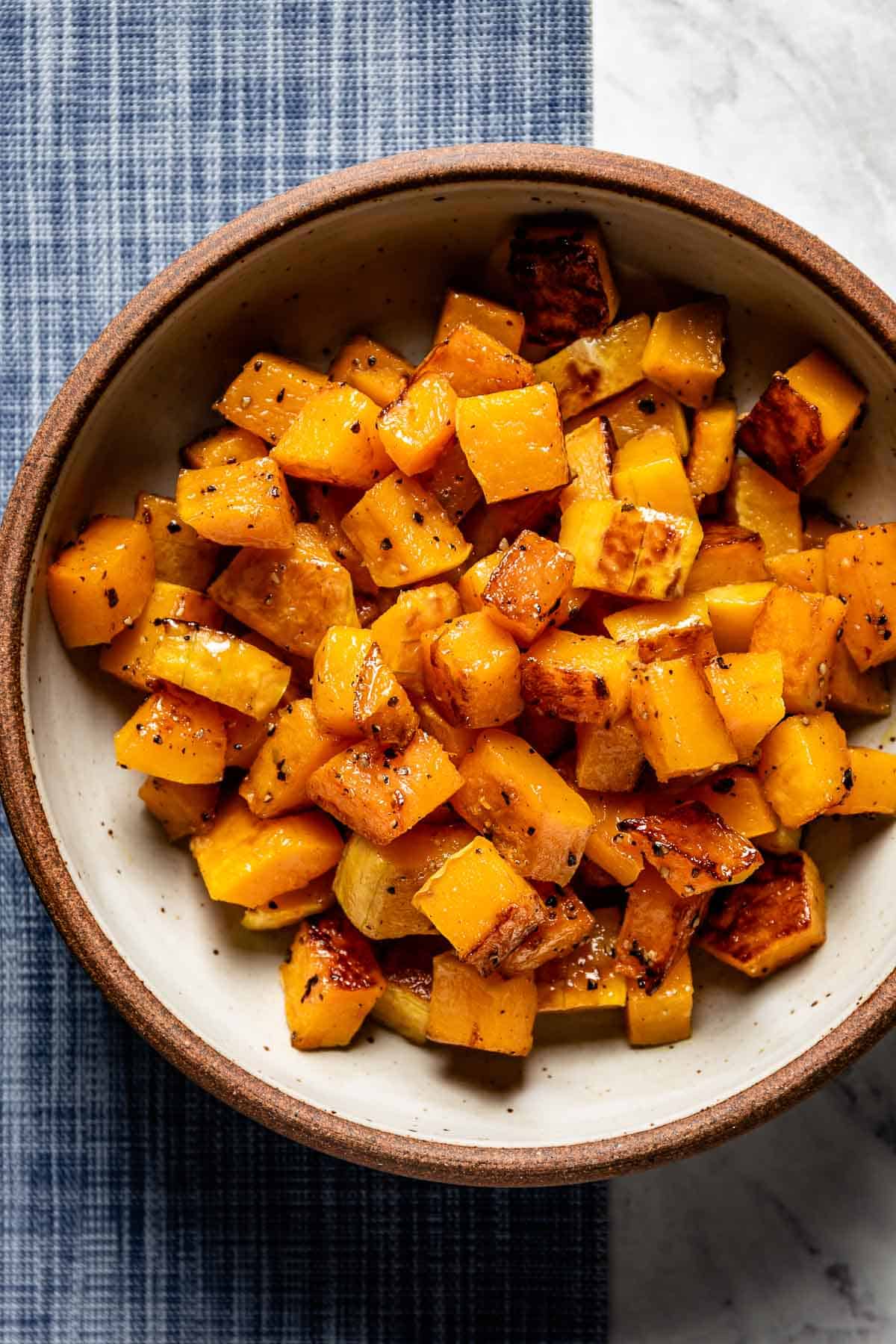
Expert tips for perfect results
- The roasting time might differ depending on the size of the butternut squash cubes: The times that are listed in the recipe below are for 1-inch cubes. If yours are larger or smaller, be aware that the bake time might be a bit longer or shorter.
- Keep an eye on it after the first 30 minutes: Whether you bake cubed butternut squash at 375, 400, or 425 degrees F, I recommend giving a toss at least once and checking it for doneness after the first 30 minutes.
- Do not overcrowd the pan: If your squash is large and you have a lot of squash, break it into two sheet pans. You can roast them simultaneously but be sure to rotate and flip them halfway through the baking process to ensure even baking.
- Should I use parchement paper? After reading this article on Food52, I decided to no longer use parchement paper when roasting vegetables. It is definetly a personal prefence, but as a big fan of the roasted caramelized flavors, I am okay with having to deal with cleaning the sheet pan later on.
FAQs:
Butternut squash is a type of winter squash that is harvested on a vine. It is grown during the summer months and harvested in the fall. It has a sweet earthy and nutty taste with high levels of fiber, vitamin A and vitamin C, magnesium, and potassium.
Although you can bake butternut squash cubes without peeling, the peel gives a very bitter taste so I would not recommend it.
Your butternut squash is fully cooked when you can insert a knife into the squash and it comes out easily.
If you enjoyed this article on How To Roast Butternut Squash Cubes and tried the recipe below, please take a minute to rate the recipe and leave a comment below. It helps others who are thinking of making the recipe. And if you took some pictures, be sure to share them on Instagram using #foolproofeats so I can share them on my stories.
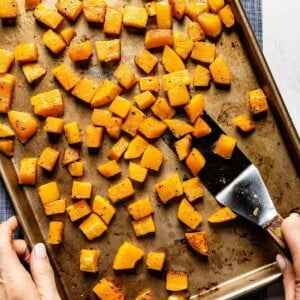
How to Roast Butternut Squash Cubes Recipe
Ingredients
- 1 medium butternut squash, about 3 pounds, cut into cubes
- 2 tablespoons olive oil or avocado oil
- 1 teaspoon kosher salt
- ½ teaspoon black pepper
- Possible seasonings
Instructions
- Adjust oven rack to middle position and preheat the oven to 425 degrees.
- Place diced butternut squash on the prepared pan. Drizzle with olive oil, salt, and black pepper. Give it a toss to ensure that all of the cubes are coated with the oil and the seasoning.
- Arrange the squash cubes on an even layer on a large baking sheet.
- Roast, turning them halfway through, for 30-35 minutes until they are lightly golden brown on the edges or until a knife inserted in one of the cubes comes in and out easily.
- Carefully transfer onto a plate and serve while still warm.
Notes
- A 3-pound butternut squash yields somewhere between 5-6 cups of roasted 1-inch butternut squash cubes.
- Can I bake butternut squash in different temperatures? When it comes to baking butternut squash cubes, I usually prefer a high temperature, 425 degrees F., oven, and bake them for 30-35 minutes. However, you can bake them in lower temperatures as well. Below, I am sharing how long to roast butternut squash cubes at 375 degrees and 400 degrees as well.
- 375 Degrees F / 40-45 minutes
- 400 Degrees F / 35-40 minutes
- 425 Degrees F / 30-35 minutes (preferred method)
Nutrition information is automatically calculated, so should only be used as an approximation.

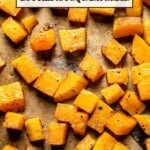
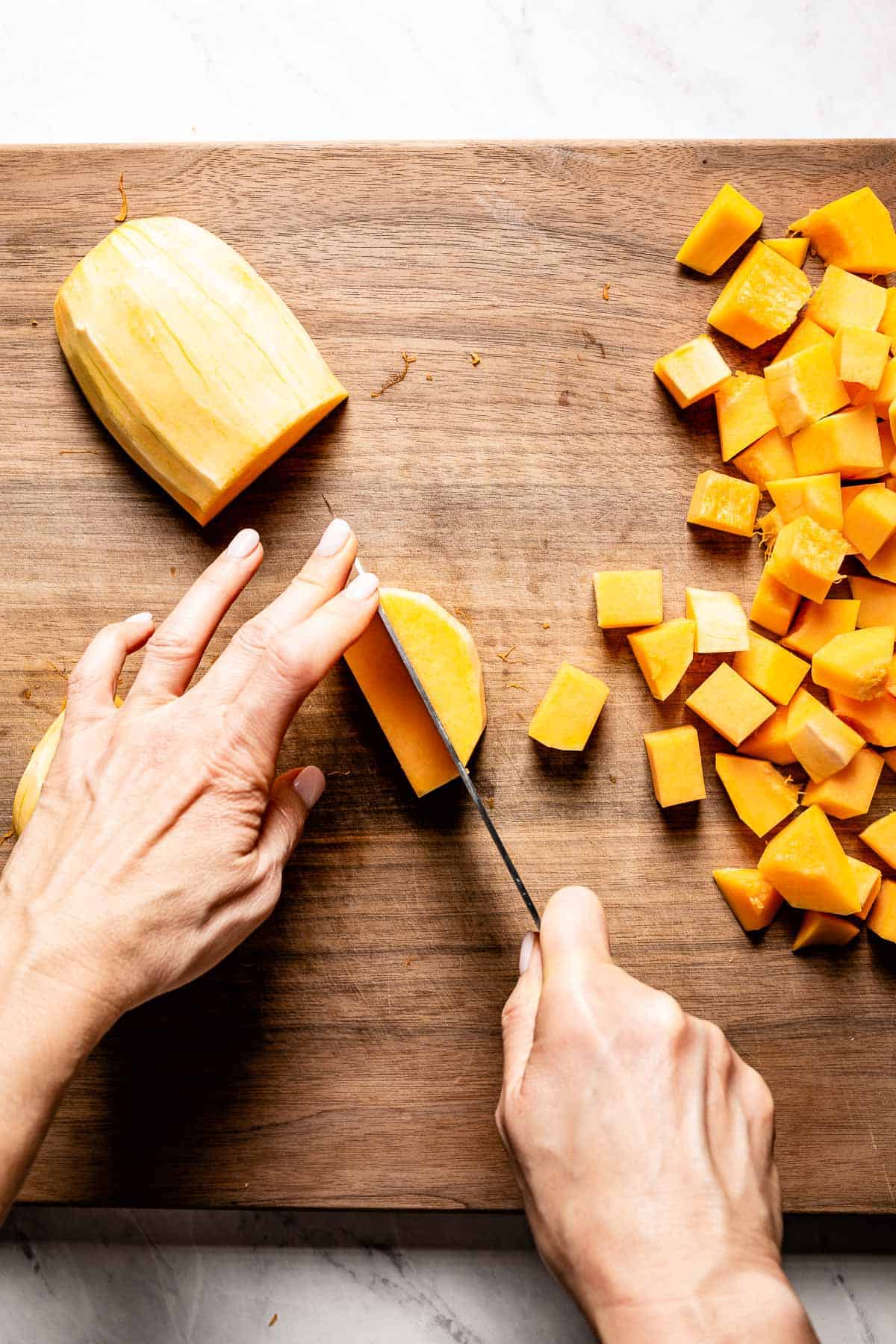
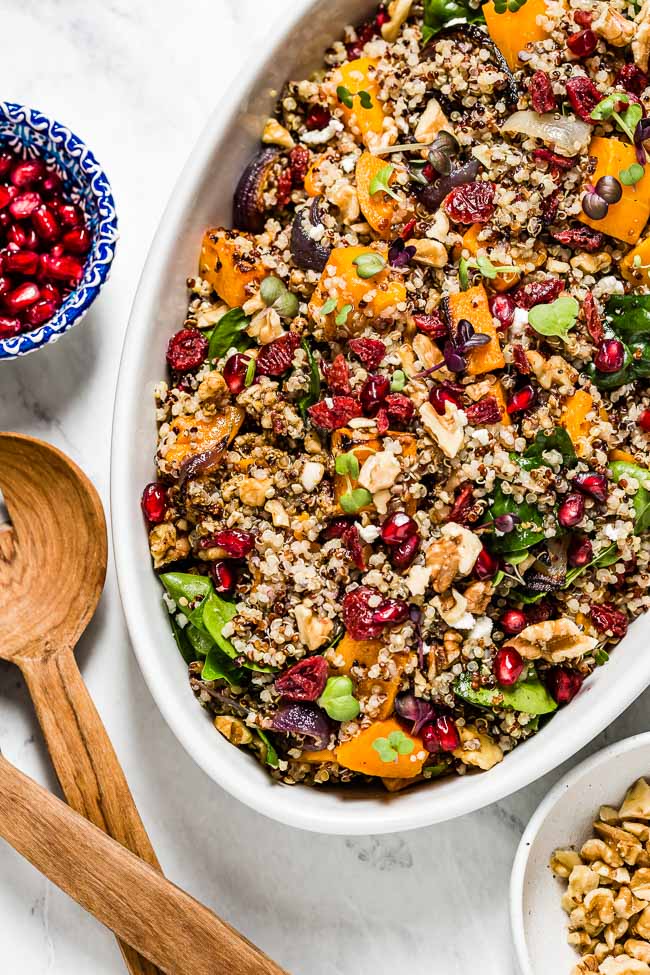

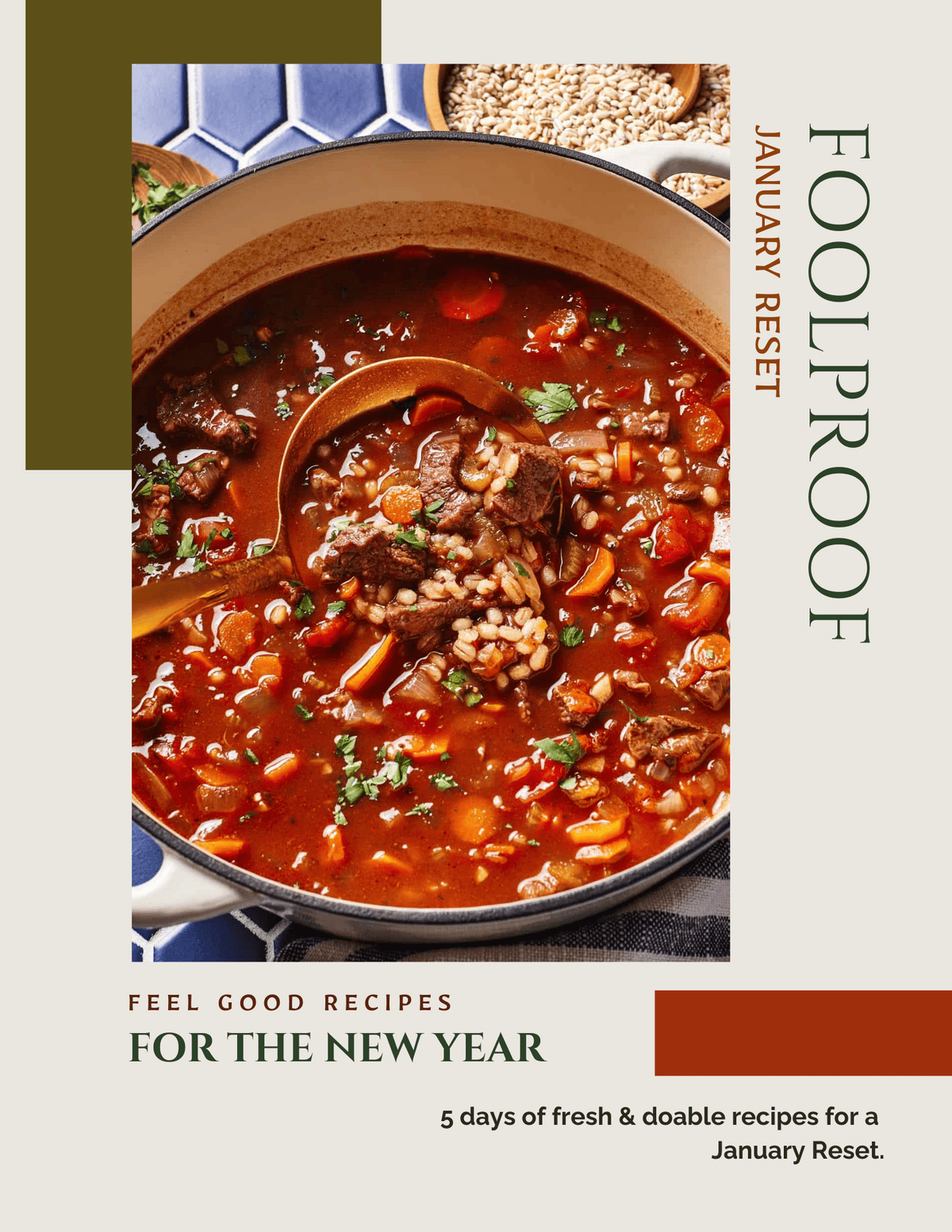









Made this today! Great easy recipes.
Thanks for coming by and taking the time to leave a review Geri.
Great article for another way to fix butternut squash. Good details and spice suggestions. Thank you!
I am happy to hear that you found it helpful Kathy. Cheers!
Ridiculous beginning instructions! Sorry, but I don’t really care to lose a finger. No way will I peel and cut up a butternut squash. Anyone knows that you put the whole squash into the microwave for three to five minutes after you’ve poked holes or slits throughout the squash. Let it cool and only THEN, do you peel and cut it up.
Linda,
I am sorry to hear that you found my instructions “ridiculous.” To be honest, I didn’t know that you could put it in the microwave to help soften it before cutting into it. While I understand that you prefer that method, I respectfully disagree with you as I believe that if you have a sharp knife and you are following my instructions as written, you can easily cut your butternut squash safely. However, next time I cut butternut squash, I will give your method a try and will update the recipe if necessary. Thanks for your input.